Parallax
This articleneeds additional citations forverification.(April 2020) |
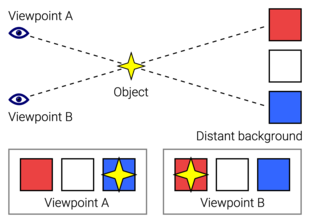
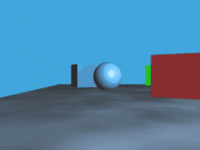
Parallaxis a displacement or difference in theapparent positionof an object viewed along two differentlines of sightand is measured by the angle orhalf-angleof inclination between those two lines.[1][2]Due toforeshortening,nearby objects show a larger parallax than farther objects, so parallax can be used to determine distances.
To measure large distances, such as the distance of a planet or a star fromEarth,astronomers use the principle of parallax. Here, the termparallaxis the semi-angle of inclination between two sight-lines to the star, as observed when Earth is on opposite sides of the Sun in its orbit.[a]These distances form the lowest rung of what is called "thecosmic distance ladder",the first in a succession of methods by which astronomers determine the distances to celestial objects, serving as a basis for other distance measurements in astronomy forming the higher rungs of the ladder.
Parallax also affects optical instruments such as rifle scopes,binoculars,microscopes,andtwin-lens reflex camerasthat view objects from slightly different angles. Many animals, along with humans, have twoeyeswith overlappingvisual fieldsthat use parallax to gaindepth perception;this process is known asstereopsis.Incomputer visionthe effect is used forcomputer stereo vision,and there is a device called aparallax rangefinderthat uses it to find the range, and in some variations also altitude to a target.
A simple everyday example of parallax can be seen in the dashboards of motor vehicles that use a needle-style mechanicalspeedometer.When viewed from directly in front, the speed may show exactly 60, but when viewed from the passenger seat, the needle may appear to show a slightly different speed due to the angle of viewing combined with the displacement of the needle from the plane of the numerical dial.
Visual perception
[edit]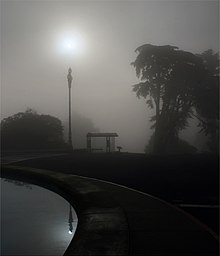
Because the eyes of humans and other animals are in different positions on the head, they present different views simultaneously. This is the basis ofstereopsis,the process by which the brain exploits the parallax due to the different views from the eye to gain depth perception and estimate distances to objects.[3]
Animals also usemotion parallax,in which the animals (or just the head) move to gain different viewpoints. For example,pigeons(whose eyes do not have overlapping fields of view and thus cannot use stereopsis) bob their heads up and down to see depth.[4] The motion parallax is exploited also inwiggle stereoscopy,computer graphics that provide depth cues through viewpoint-shifting animation rather than through binocular vision.
Distance measurement
[edit]
Parallax arises due to a change in viewpoint occurring due to the motion of the observer, of the observed, or both. What is essential is relative motion. By observing parallax,measuringangles,and usinggeometry,one can determinedistance.
Distance measurementby parallax is a special case of the principle oftriangulation,which states that one can solve for all the sides and angles in a network of triangles if, in addition to all the angles in the network, the length of at least one side has been measured. Thus, the careful measurement of the length of one baseline can fix the scale of an entire triangulation network. In parallax, the triangle is extremely long and narrow, and by measuring both its shortest side (the motion of the observer) and the small top angle (always less than 1arcsecond,[5]leaving the other two close to 90 degrees), the length of the long sides (in practice considered to be equal) can be determined.
In astronomy, assuming the angle is small, the distance to a star (measured inparsecs) is thereciprocalof the parallax (measured inarcseconds):For example, the distance toProxima Centauriis 1/0.7687 = 1.3009 parsecs (4.243 ly).[6]
On Earth, acoincidence rangefinderor parallax rangefinder can be used to find distance to a target. Insurveying,the problem ofresectionexplores angular measurements from a known baseline for determining an unknown point's coordinates.
Astronomy
[edit]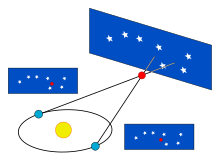

The most important fundamentaldistance measurementsinastronomycome from trigonometric parallax, as applied in thestellar parallax method.As the Earth orbits the Sun, the position of nearby stars will appear to shift slightly against the more distant background. These shifts are angles in anisosceles triangle,with 2AU(the distance between the extreme positions of Earth's orbit around the Sun) making the base leg of the triangle and the distance to the star being the long equal-length legs. The amount of shift is quite small, even for the nearest stars, measuring 1arcsecondfor an object at 1 parsec's distance (3.26light-years), and thereafter decreasing in angular amount as the distance increases. Astronomers usually express distances in units ofparsecs(parallax arcseconds); light-years are used in popular media.
Because parallax becomes smaller for a greater stellar distance, useful distances can be measured only for stars which are near enough to have a parallax larger than a few times theprecisionof the measurement. In the 1990s, for example, theHipparcosmission obtained parallaxes for over a hundred thousand stars with a precision of about amilliarcsecond,[7]providing useful distances for stars out to a few hundred parsecs. TheHubble Space Telescope'sWide Field Camera 3has the potential to provide a precision of 20 to 40microarcseconds, enabling reliable distance measurements up to 5,000 parsecs (16,000 ly) for small numbers of stars.[8][9]TheGaiaspace mission provided similarly accurate distances to most stars brighter than 15th magnitude.[10]
Distances can be measured within 10% as far as theGalactic Center,about 30,000 light years away. Stars have a velocity relative to the Sun that causesproper motion(transverse across the sky) andradial velocity(motion toward or away from the Sun). The former is determined by plotting the changing position of the stars over many years, while the latter comes from measuring theDoppler shiftof the star's spectrum caused by motion along the line of sight. For a group of stars with the same spectral class and a similar magnitude range, a mean parallax can be derived fromstatistical analysisof the proper motions relative to their radial velocities. Thisstatistical parallaxmethod is useful for measuring the distances of bright stars beyond 50 parsecs and giantvariable stars,includingCepheidsand theRR Lyrae variables.[11]


The motion of the Sun through space provides a longer baseline that will increase the accuracy of parallax measurements, known assecular parallax.For stars in theMilky Waydisk, this corresponds to a mean baseline of 4AUper year, while for halo stars the baseline is 40 AU per year. After several decades, the baseline can be orders of magnitude greater than the Earth–Sun baseline used for traditional parallax. However, secular parallax introduces a higher level of uncertainty because the relative velocity of observed stars is an additional unknown. When applied to samples of multiple stars, the uncertainty can be reduced; the uncertainty is inversely proportional to thesquare rootof the sample size.[14]
Moving cluster parallaxis a technique where the motions of individual stars in a nearby star cluster can be used to find the distance to the cluster. Onlyopen clustersare near enough for this technique to be useful. In particular the distance obtained for theHyadeshas historically been an important step in the distance ladder.
Other individual objects can have fundamental distance estimates made for them under special circumstances. If the expansion of a gas cloud, like asupernova remnantorplanetary nebula,can be observed over time, then anexpansion parallaxdistance to that cloud can be estimated. Those measurements however suffer from uncertainties in the deviation of the object from sphericity.Binary starswhich are bothvisualandspectroscopicbinaries also can have their distance estimated by similar means, and do not suffer from the above geometric uncertainty. The common characteristic to these methods is that a measurement of angular motion is combined with a measurement of the absolutevelocity(usually obtained via theDoppler effect). The distance estimate comes from computing how far the object must be to make its observed absolute velocity appear with the observed angular motion.
Expansion parallaxes in particular can give fundamental distance estimates for objects that are very far, because supernova ejecta have large expansion velocities and large sizes (compared to stars). Further, they can be observed with radiointerferometerswhich can measure very small angular motions. These combine to provide fundamental distance estimates to supernovae in other galaxies.[15]Though valuable, such cases are quite rare, so they serve as important consistency checks on the distance ladder rather than workhorse steps by themselves.
Metrology
[edit]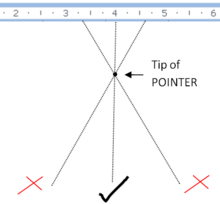
Measurements made by viewing the position of some marker relative to something to be measured are subject to parallax error if the marker is some distance away from the object of measurement and not viewed from the correct position. For example, if measuring the distance between two ticks on a line with a ruler marked on its top surface, the thickness of the ruler will separate its markings from the ticks. If viewed from a position not exactly perpendicular to the ruler, the apparent position will shift and the reading will be less accurate than the ruler is capable of.
A similar error occurs when reading the position of a pointer against a scale in an instrument such as an analogmultimeter.To help the user avoid this problem, the scale is sometimes printed above a narrow strip ofmirror,and the user's eye is positioned so that the pointer obscures its reflection, guaranteeing that the user's line of sight is perpendicular to the mirror and therefore to the scale. The same effect alters the speed read on a car's speedometer by a driver in front of it and a passenger off to the side, values read from agraticule,not in actual contact with the display on anoscilloscope,etc.
Photogrammetry
[edit]When viewed through a stereo viewer, aerial picture pair offers a pronounced stereo effect of landscape and buildings. High buildings appear to "keel over" in the direction away from the center of the photograph. Measurements of this parallax are used to deduce the height of the buildings, provided that flying height and baseline distances are known. This is a key component of the process ofphotogrammetry.
Photography
[edit]Parallax error can be seen when taking photos with many types of cameras, such astwin-lens reflex camerasand those includingviewfinders(such asrangefinder cameras). In such cameras, the eye sees the subject through different optics (the viewfinder, or a second lens) than the one through which the photo is taken. As the viewfinder is often found above the lens of the camera, photos with parallax error are often slightly lower than intended, the classic example being the image of a person with their head cropped off. This problem is addressed insingle-lens reflex cameras,in which the viewfinder sees through the same lens through which the photo is taken (with the aid of a movable mirror), thus avoiding parallax error.
Parallax is also an issue inimage stitching,such as for panoramas.
-
Contax III rangefinder camera withmacro photographysetting. Because the viewfinder is on top of the lens and near the subject, goggles are fitted in front of the rangefinder and a dedicated viewfinder is installed to compensate for parallax.
-
Failed panoramic image due to the parallax, since the axis of rotation of the tripod is not the same as the focal point.
Weapon sights
[edit]Parallax affectssighting devicesofranged weaponsin many ways. On sights fitted onsmall armsandbows,etc., the perpendicular distance between the sight and the weapon's launch axis (e.g. thebore axisof a gun)—generally referred to as "sight height"—can induce significant aiming errors when shooting at close range, particularly when shooting at small targets.[16]This parallax error is compensated for (when needed) via calculations that also take in other variables such asbullet drop,windage,and the distance at which the target is expected to be.[17]Sight height can be used to advantage when "sighting in" rifles for field use. A typical hunting rifle (.222 with telescopic sights) sighted in at 75m will still be useful from 50 to 200 m (55 to 219 yd) without needing further adjustment.[citation needed]
Optical sights
[edit]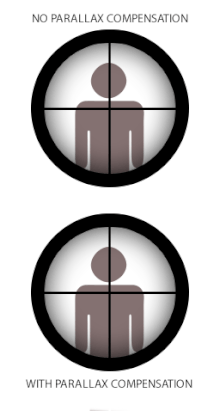
In somereticledoptical instrumentssuch astelescopes,microscopesor intelescopic sights( "scopes" ) used onsmall armsandtheodolites,parallax can create problems when the reticle is notcoincidentwith thefocal planeof the target image. This is because when the reticle and the target are not at the same focus, the optically corresponded distances being projected through theeyepieceare also different, and the user's eye will register the difference in parallaxes between the reticle and the target (whenever eye position changes) as a relative displacement on top of each other. The termparallax shiftrefers to the resultant apparent "floating" movements of the reticle over the target image when the user moves his/her head/eye laterally (up/down or left/right) behind the sight,[18]i.e. an error where the reticle does not stay aligned with the user'soptical axis.
Some firearm scopes are equipped with a parallax compensation mechanism, which consists of a movable optical element that enables the optical system to shift the focus of the target image at varying distances into the same optical plane of the reticle (or vice versa). Many low-tier telescopic sights may have no parallax compensation because in practice they can still perform very acceptably without eliminating parallax shift. In this case, the scope is often set fixed at a designated parallax-free distance that best suits their intended usage. Typical standard factory parallax-free distances for hunting scopes are 100 yd (or 90 m) to make them suited for hunting shots that rarely exceed 300 yd/m. Some competition and military-style scopes without parallax compensation may be adjusted to be parallax free at ranges up to 300 yd/m to make them better suited for aiming at longer ranges.[citation needed]Scopes for guns with shorter practical ranges, such asairguns,rimfire rifles,shotguns,andmuzzleloaders,will have parallax settings for shorter distances, commonly 50 m (55 yd) for rimfire scopes and 100 m (110 yd) for shotguns and muzzleloaders.[citation needed]Airgun scopes are very often found with adjustable parallax, usually in the form of an adjustable objective (or "AO" for short) design, and may adjust down to as near as 3 metres (3.3 yd).[citation needed]
Non-magnifyingreflector or "reflex" sightscan be theoretically "parallax free." But since these sights use parallelcollimated lightthis is only true when the target is at infinity. At finite distances, eye movement perpendicular to the device will cause parallax movement in the reticle image in exact relationship to the eye position in the cylindrical column of light created by the collimating optics.[19][20]Firearm sights, such as somered dot sights,try to correct for this via not focusing the reticle at infinity, but instead at some finite distance, a designed target range where the reticle will show very little movement due to parallax.[19]Some manufacturers market reflector sight models they call "parallax free,"[21]but this refers to an optical system that compensates for off axisspherical aberration,an optical error induced by the spherical mirror used in the sight that can cause the reticle position to diverge off the sight'soptical axiswith change in eye position.[22][23]
Artillery gunfire
[edit]Because of the positioning offieldornaval artilleryguns, each one has a slightly different perspective of the target relative to the location of thefire-control systemitself. Therefore, when aiming its guns at the target, the fire control system must compensate for parallax in order to assure thatfirefrom each gun converges on the target.
Art
[edit]Several ofMark Renn's sculptural works play with parallax, appearing abstract until viewed from a specific angle. One such sculpture isThe Darwin Gate(pictured) inShrewsbury,England, which from a certain angle appears to form a dome, according toHistoric England,in "the form of a Saxon helmet with a Norman window... inspired by features of St Mary's Church which was attended by Charles Darwin as a boy".[24]
As a metaphor
[edit]In a philosophic/geometric sense: an apparent change in the direction of an object, caused by a change in observational position that provides a new line of sight. The apparent displacement, or difference of position, of an object, as seen from two different stations, or points of view. In contemporary writing, parallax can also be the same story, or a similar story from approximately the same timeline, from one book, told from a different perspective in another book. The word and concept feature prominently inJames Joyce's 1922 novel,Ulysses.Orson Scott Cardalso used the term when referring toEnder's Shadowas compared toEnder's Game.
The metaphor is invoked by Slovenian philosopherSlavoj Žižekin his 2006 bookThe Parallax View,borrowing the concept of "parallax view" from the Japanese philosopher and literary criticKojin Karatani.Žižek notes
The philosophical twist to be added (to parallax), of course, is that the observed distance is not simply "subjective", since the same object that exists "out there" is seen from two different stances or points of view. It is rather that, asHegelwould have put it, subject and object are inherently "mediated" so that an "epistemological"shift in the subject's point of view always reflects an"ontological"shift in the object itself. Or—to put it inLacanese—the subject's gaze is always already inscribed into the perceived object itself, in the guise of its "blind spot," that which is "in the object more than the object itself," the point from which the object itself returns the gaze. "Sure the picture is in my eye, but I am also in the picture"...[25]
— Slavoj Žižek,The Parallax View
See also
[edit]- Binocular disparity
- Lutz–Kelker bias
- Parallax mapping,in computer graphics
- Parallax scrolling,in computer graphics
- Spectroscopic parallax
- Triangulation,wherein a point is calculated given its angles from other known points
- Trigonometry
- True range multilateration,wherein a point is calculated given its distances from other known points
- Xallarap
Notes
[edit]- ^In the pastdiurnal parallaxwas also used to measure distances to celestial objects within theSolar System.This method has now been superseded by more accurate techniques.
References
[edit]- ^"Parallax".Shorter Oxford English Dictionary.1968.
Mutual inclination of two lines meeting in an angle
- ^"Parallax".Oxford English Dictionary(Second ed.). 1989.
Astron.Apparent displacement, or difference in the apparent position, of an object, caused by an actual change (or difference) of the position of the point of observation; spec. the angular amount of such displacement or difference of position, being the angle contained between the two straight lines drawn to the object from the two different points of view and constituting a measure of the distance of the object.
- ^Steinman, Scott B.; Garzia, Ralph Philip (2000).Foundations of Binocular Vision: A Clinical perspective.McGraw-Hill Professional. pp. 2–5.ISBN978-0-8385-2670-5.
- ^Steinman & Garzia 2000,p. 180.
- ^Zeilik & Gregory 1998,p. 44.
- ^Benedict, G. Fritz, et al. (1999). "Interferometric Astrometry of Proxima Centauri and Barnard's Star Using Hubble Space Telescope Fine Guidance Sensor 3: Detection Limits for Substellar Companions".The Astronomical Journal.118(2): 1086–1100.arXiv:Astro-ph/9905318.Bibcode:1999AJ....118.1086B.doi:10.1086/300975.S2CID18099356.
- ^ Perryman, M. A. C.; et al. (1999). "The HIPPARCOS Catalogue".Astronomy and Astrophysics.323:L49–L52.Bibcode:1997A&A...323L..49P.
- ^Harrington, J. D.; Villard, R. (10 April 2014)."NASA's Hubble Extends Stellar Tape Measure 10 Times Farther Into Space".NASA.Archivedfrom the original on 17 February 2019.Retrieved17 October2014.
- ^ Riess, A. G.; Casertano, S.; Anderson, J.; MacKenty, J.; Filippenko, A. V. (2014). "Parallax Beyond a Kiloparsec from Spatially Scanning the Wide Field Camera 3 on the Hubble Space Telescope".The Astrophysical Journal.785(2): 161.arXiv:1401.0484.Bibcode:2014ApJ...785..161R.doi:10.1088/0004-637X/785/2/161.S2CID55928992.
- ^Brown, A. G. A.;et al. (Gaia collaboration) (August 2018)."GaiaData Release 2: Summary of the contents and survey properties ".Astronomy & Astrophysics.616.A1.arXiv:1804.09365.Bibcode:2018A&A...616A...1G.doi:10.1051/0004-6361/201833051.
- ^ B., Baidyanath (2003).An Introduction to Astrophysics.PHI Learning Private Limited.ISBN978-81-203-1121-3.
- ^"Hubble finds Universe may be expanding faster than expected".Archivedfrom the original on 11 September 2018.Retrieved3 June2016.
- ^"Hubble stretches the stellar tape measure ten times further".ESA/Hubble Images.Archivedfrom the original on October 30, 2017.RetrievedApril 12,2014.
- ^ Popowski, P.; Gould, A. (1998). "Mathematics of Statistical Parallax and the Local Distance Scale".arXiv:astro-ph/9703140.
- ^ Bartel, N.; et al. (1994). "The shape, expansion rate and distance of supernova 1993J from VLBI measurements".Nature.368(6472): 610–613.Bibcode:1994Natur.368..610B.doi:10.1038/368610a0.S2CID4316734.
- ^"Ballistic Explorer Help".dexadine.Archivedfrom the original on 2011-09-28.
- ^"Crossbows / Arrows & Bolts / Trajectory / Trajectories".crossbowmen.Archivedfrom the original on 2011-07-08.
- ^"Setting Up An Air Rifle And Telescopic Sight For Field Target – An Instruction Manual For Beginners, page 16".Retrieved2019-10-28.
- ^ab"Encyclopedia of Bullseye Pistol".bullseyepistol.Archivedfrom the original on 2011-07-08.
- ^John P. Butler (1944). "The Reflector Sight".American Rifleman.National Rifle Association. p. 31.
- ^AFMOTGN (24 July 2008)."Aimpoint's parallax-free, double lens system... AFMO".Archivedfrom the original on 2 July 2016 – via YouTube.
- ^AR15.COM."How Aimpoints, EOTech, And Other Parallax-Free Optics Work – AR15.COM".ar15.
{{cite web}}:CS1 maint: numeric names: authors list (link) - ^"Gunsight – Patent 5901452 – general description of a mManginmirror system".Archivedfrom the original on 2012-10-07.
- ^Historic England."Darwin Gate (1490992)".Research records (formerly PastScape).Retrieved4 January2020.
- ^Žižek, Slavoj(2006).The Parallax View.The MIT Press. pp.17.ISBN978-0-262-24051-2.
Bibliography
[edit]- Hirshfeld, Alan w. (2001).Parallax: The Race to Measure the Cosmos.New York: W.H. Freeman.ISBN978-0-7167-3711-7.
- Whipple, Fred L. (2007).Earth Moon and Planets.Read Books.ISBN978-1-4067-6413-0..
- Zeilik, Michael A.; Gregory, Stephan A. (1998).Introductory Astronomy & Astrophysics(4th ed.). Saunders College Publishing.ISBN978-0-03-006228-5.
External links
[edit]- Instructions for having background images on a web page use parallax effects
- Actual parallax project measuring the distance to the moon within 2.3%
- BBC'sSky at Nightprogram: Patrick Moore demonstrates Parallax using Cricket. (RequiresRealPlayer)
- Berkeley Center for Cosmological PhysicsParallax
- Parallaxon an educational website, including a quick estimate of distance based on parallax using eyes and a thumb only
- .Collier's New Encyclopedia.1921.





